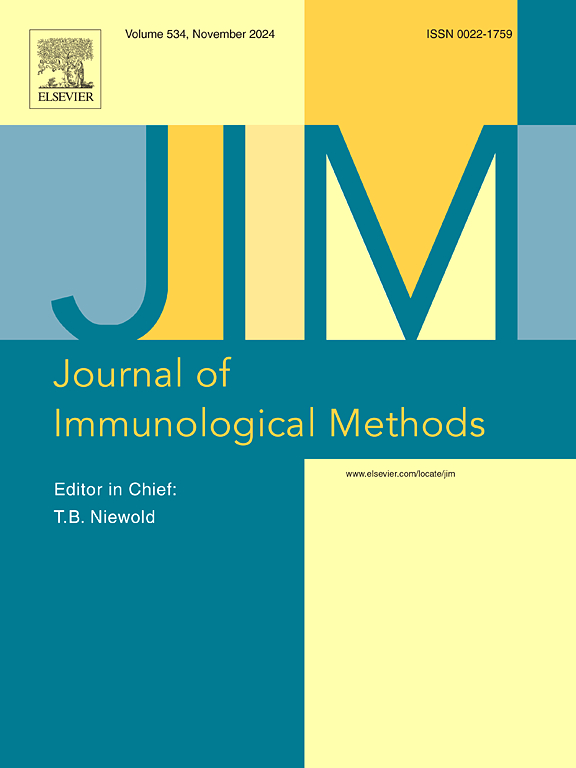A novel whole blood assay to quantify the release of T cell associated cytokines in response to Bordetella pertussis antigens
IF 1.6
4区 医学
Q4 BIOCHEMICAL RESEARCH METHODS
引用次数: 0
Abstract
Background
Bordetella pertussis continues to cause whooping cough globally even in countries with high immunisation coverage. Booster vaccinations with acellular pertussis vaccines are thus used in children, adolescents, and adults. T cell immunity is crucial for orchestrating the immune response after vaccination. However, T cell assays can be expensive and difficult to implement in large clinical trials. In this study, a whole blood (WB) stimulation assay was developed to identify secreted T cell associated cytokines in different age groups after acellular pertussis booster vaccination.
Material and methods
Longitudinal WB samples were collected from a small set of subjects (n = 38) aged 7–70 years participating in a larger ongoing clinical trial. For assay development, samples were diluted and incubated with purified inactivated pertussis toxin (PT), filamentous haemagglutinin (FHA), inactivated B. pertussis lysate, and complete medium (M) as stimulating conditions, with anti-CD28 and anti-CD49d as co-stimulants. Different timepoints around the vaccination (D0, D7, D14, D28), WB dilution factor (1:2, 1:4) and incubation time (24 h, 48 h, 72 h) were compared. Responses to 15 cytokines were tested with Luminex/multiplex immunoassay.
Results
The optimized assay consisted of WB incubation with M, PT, and FHA (including the two co-stimulants). After 48 h incubation, supernatants were collected for measurement of seven selected T cell associated cytokines (IL-2, IL-5, IL-10, IL-13, IL-17 A, IL-17F, and IFN-y) from samples before and 28 days after vaccination. PT stimulation showed a trend for upregulation of IL-2, IL-13, and IL-17 A/F for adult subjects, whereas the responses of all cytokines were downregulated for the paediatric subjects. Furthermore, PT and FHA-stimulated WB showed diverse cytokine producing profiles.
Conclusions
The developed WB-based cytokine assay was shown to be less costly, easy to perform, and functional in differently aged individuals. Further, it requires only a small amount of fresh blood, which is beneficial especially for studies including infants. Our results support the use of this assay for other immunological studies in the future.
一种新型全血测定法,用于量化百日咳博德特氏菌抗原反应中 T 细胞相关细胞因子的释放。
背景:即使在免疫覆盖率较高的国家,百日咳博德特氏菌仍会在全球引起百日咳。因此,无细胞百日咳疫苗被用于儿童、青少年和成人的加强免疫接种。T 细胞免疫对疫苗接种后的免疫反应至关重要。然而,T 细胞检测昂贵且难以在大型临床试验中实施。在这项研究中,我们开发了一种全血(WB)刺激测定法,用于识别不同年龄组接种无细胞百日咳加强免疫后分泌的T细胞相关细胞因子:纵向 WB 样本采集自一小批参与正在进行的大型临床试验的 7-70 岁受试者(n = 38)。为了开发检测方法,样本经稀释后与纯化的灭活百日咳毒素(PT)、丝状血凝素(FHA)、灭活百日咳杆菌裂解物和完全培养基(M)一起孵育,并以抗 CD28 和抗 CD49d 作为辅助刺激剂。比较了疫苗接种前后的不同时间点(D0、D7、D14、D28)、WB 稀释因子(1:2、1:4)和孵育时间(24 小时、48 小时、72 小时)。用 Luminex/多重免疫测定法检测了对 15 种细胞因子的反应:优化的检测方法包括用 M、PT 和 FHA(包括两种辅助刺激剂)进行 WB 培养。培养 48 小时后,收集上清液以测定疫苗接种前和接种后 28 天样本中的七种选定 T 细胞相关细胞因子(IL-2、IL-5、IL-10、IL-13、IL-17 A、IL-17F 和 IFN-y)。在 PT 刺激下,成人受试者的 IL-2、IL-13 和 IL-17 A/F 呈上调趋势,而儿科受试者的所有细胞因子反应均呈下调趋势。此外,PT 和 FHA 刺激的白细胞显示出不同的细胞因子产生情况:结论:所开发的基于 WB 的细胞因子检测方法成本较低、操作简便,而且可用于不同年龄的个体。此外,它只需要少量新鲜血液,这对包括婴儿在内的研究尤其有利。我们的研究结果支持将来将这种检测方法用于其他免疫学研究。
本文章由计算机程序翻译,如有差异,请以英文原文为准。
求助全文
约1分钟内获得全文
求助全文
来源期刊
CiteScore
4.10
自引率
0.00%
发文量
120
审稿时长
3 months
期刊介绍:
The Journal of Immunological Methods is devoted to covering techniques for: (1) Quantitating and detecting antibodies and/or antigens. (2) Purifying immunoglobulins, lymphokines and other molecules of the immune system. (3) Isolating antigens and other substances important in immunological processes. (4) Labelling antigens and antibodies. (5) Localizing antigens and/or antibodies in tissues and cells. (6) Detecting, and fractionating immunocompetent cells. (7) Assaying for cellular immunity. (8) Documenting cell-cell interactions. (9) Initiating immunity and unresponsiveness. (10) Transplanting tissues. (11) Studying items closely related to immunity such as complement, reticuloendothelial system and others. (12) Molecular techniques for studying immune cells and their receptors. (13) Imaging of the immune system. (14) Methods for production or their fragments in eukaryotic and prokaryotic cells.
In addition the journal will publish articles on novel methods for analysing the organization, structure and expression of genes for immunologically important molecules such as immunoglobulins, T cell receptors and accessory molecules involved in antigen recognition, processing and presentation. Submitted full length manuscripts should describe new methods of broad applicability to immunology and not simply the application of an established method to a particular substance - although papers describing such applications may be considered for publication as a short Technical Note. Review articles will also be published by the Journal of Immunological Methods. In general these manuscripts are by solicitation however anyone interested in submitting a review can contact the Reviews Editor and provide an outline of the proposed review.

 求助内容:
求助内容: 应助结果提醒方式:
应助结果提醒方式:


